At Dorset History Centre, we hold a large number of fascinating collections which tell of a rich history. One such collection is that of Loewy Engineering of Bournemouth…
—
The County of Dorset has been home to many individuals, men and women who in their own specialist fields have made a great impact upon society worldwide whether it be in the form of literature, music and the arts, evolution or science and technology.
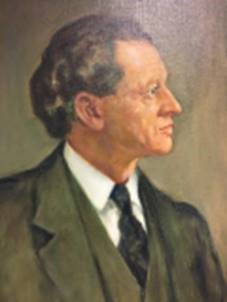
Amongst those who have contributed so much was a man born in 1887 a long way from Dorset. Ludwig Loewy, one of 9 children born into a Jewish family in Becov, near Caribad, Bohemia – now the Czech Republic. His Jewish birth was to play a significant role in his later life as well as for his brothers Erwin, Siegmund, Alfred and their sister Erma all of whom more shall be known later.
Early Days
As a schoolboy Ludwig showed himself to be exceptionally talented in many ways and in his late ‘teens he had to decide whether to pursue a musical career or to study to become a professional engineer. He chose the latter and graduated from Vienna University with an engineering degree. He joined a German shipbuilder and then moved on to the Schloemann Company, Dusseldorf a relatively small German engineering company. It was 1914, the beginning of WW1 and Schloemann was involved in manufacturing specialised industrial machinery, mainly armaments for the German war effort.
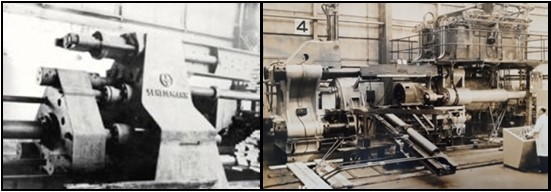
In the years following the end of the war, Ludwig’s engineering design expertise and world travels secured many orders, resulting in Schloemann expanding to become a world leading manufacturer of extremely large and powerful industrial hydraulic presses for use in the production of aluminium and steel used in the construction of aircraft, road vehicles and many other products. Because of his outstanding technical and sales abilities, Ludwig rose rapidly to become Chairman and this, coupled with his confidence and enthusiasm resulted in him investing a considerable sum of his own money in Schloemann, eventually owning 45% of the Company shares.
In spite of his modest personal lifestyle, Ludwig always showed himself to be generous to the 200-300 staff who worked for him. It is reported that on the occasion of the annual Christmas festivities, the needy Protestant, Catholic and Jewish citizens in Dusseldorf were invited and received valuable gifts of money and other kind.
Darkening Clouds
With the rise of German nationalism in the 1930’s and increasing attacks on the Jewish community, Ludwig decided in 1936 to resign his position of Chairman of Schloemann and leave the Company. When he left, such was the respect he commanded within the company, a long queue formed outside his office and every employee shook his hand.
He moved to England with his Commercial Manager, Konrad Guttenstein and together with some of his designers set up his own company in Ingersoll House, Kingsway, London. The Loewy Engineering Company was registered on 1st April 1936. Germany’s loss was Britain’s gain.
With the contacts Ludwig Loewy had previously made in Britain whilst working at Schloemann and because German engineering expertise was so highly respected, when it was known that a company now existed in the UK employing German engineers, the business grew rapidly securing orders for the design of various special presses including those specifically designed for aircraft manufacture. This attracted the attention of Lord Beaverbrook, Minister for Aviation who, with WW2 looming, was concerned with the rapid build-up of UK aircraft production, and it is reported he became a close friend of Ludwig.
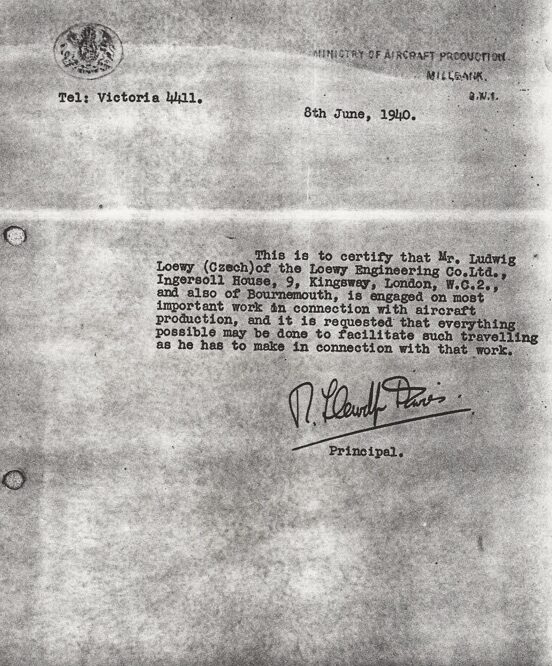
As Nazi interference increased, a number of Schloemann staff followed Ludwig to London, bringing Schloemann design drawings with them. These people were joined by Poles and other Europeans as well as UK staff. Initially, Ludwig had intended to continue working in association with Schloemann but when the German company refused to let him sell his 45% shareholding resulting in him losing a considerable amount of his personal money, he severed all connection with Schloemann which then became totally owned by the Nazis.
Relocation
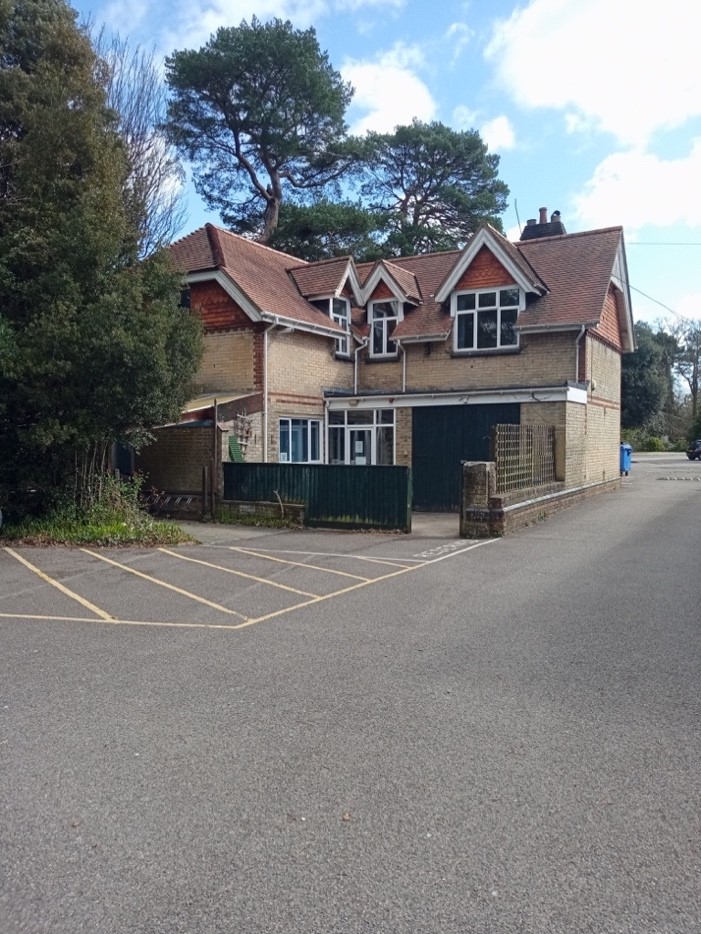
Owing to the threat of bombing, Ludwig Loewy (persuaded by Lord Beaverbrook), on 26th September 1939 relocated his staff, office furniture and design equipment over a weekend to Poole (wrongly described at the time as Bournemouth). The company started its new life in “Branksome Grange” a large Edwardian House in Lindsay Road, Branksome Park, Poole. The 80 or so employees who moved from London were allocated accommodation in local houses on a rental basis. It is said they were overwhelmed by the leafy suburb with its trees, large Edwardian houses and gardens.
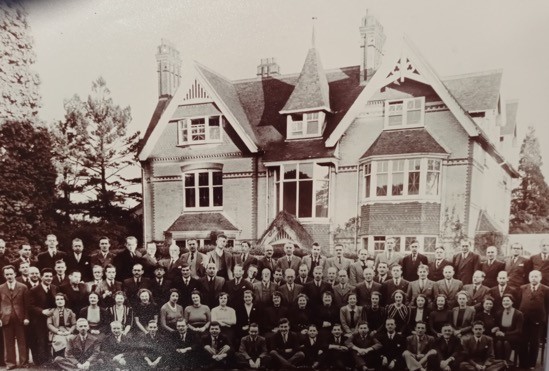
After settling into their new office accommodation, every room was used by draughtsmen standing at what would be described now as old-fashioned drawing boards. There were no carpets on the floors, and there were bare floorboards with cardboard used as floor coverings in corridors. The windows were taped to prevent the glass shattering in the event of bomb blasts, and employees doubled up as Fire Watch Wardens during air raid alarms.
Strange Times….Strange Rules.
At the beginning of the war, most of the non-British employees were called to London and vetted by MI5 or MI6. Most were cleared and allowed to resume work; some however were interned, or to be more accurate, given “house arrest” for the duration of the war. Their cameras and radios were confiscated but they were allowed to go into neighbours to listen to the radio. They could ride their bikes into Poole but not into Bournemouth. Consequently, they would ride or walk to nearby Westbourne and take the trolley bus into Bournemouth. How they explained their prohibited excursions if asked to show their identity cards is not known!
Two of Ludwig’s brothers Siegmund and Alfred followed him to England and worked for the company at Branksome Grange. Their brother Erwin and his family were being hunted by the Nazis but by hiding in various locations in France, they managed to escape by ship from Lisbon, Portugal and settled in the USA. There, Erwin established an identical company, Loewy-Hydropress in New York, designing and manufacturing similar massive hydraulic presses for the American war effort. Their sister Erma and brother Alfred joined Erwin in the USA, both working for Loewy-Hydropress.
Work continued apace in New York and Poole with many orders being received and completed for the design and manufacture of presses and rolling mills for the war effort. There was a close working collaboration between the New York office and Poole office with frequent exchanges of design drawings.
In 1940, just before the Dunkirk evacuation, one of the German speaking employees who held a Swiss passport, managed to get into occupied Europe and bring out Ludwig’s elderly parents and escort them to the USA where they settled. It is not known the fate of Ludwig’s remaining siblings but it is believed some relatives were sent to concentration camps. Because of his personal contribution in assisting the UK war effort, Ludwig was awarded British citizenship in January 1942, an extremely rare occurrence for an ‘alien’.
The Hydropress Company in New York was similarly considered by the USA Government to have made an immense contribution to the American arms war effort in the same way as the UK Government recognised the Loewy Engineering Company in Poole. The Loewy Institute at Lehigh University, USA is named and dedicated to the two Jewish brothers as being amongst the great unsung heroes of WW2.
Tragedy
In July 1942 Siegmund was suddenly taken ill whilst working late one evening at the office. A doctor was called but he died before arrival at the hospital. He was 45. The toll of overworking also affected Ludwig and he became very ill.
Because of his company’s contribution to the UK war effort, he was held in such high regard by the UK Government that an RAF ambulance plane was arranged to fly him to the USA for him to rest and recuperate.
Tragically, on the morning of Saturday 10th October 1942, the day he was due to fly, Ludwig died at the age of 55, just 3 months after his brother. It is reported that before the weekend was over, 80 telegrams of sympathy were received in the Poole office from Members of Parliament and other officials.
Ludwig Loewy is buried in the Jewish part of Boscombe Cemetery, Bournemouth, along with his brother Siegmund.

A New Beginning, A New Location
The company continued successfully in “Branksome Grange” under the Chairmanship of Konrad Guttenstein, the only one of the original German directors left in the UK.
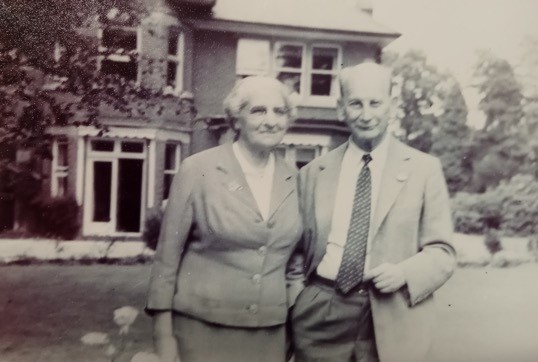
In 1954 with the Loewy Company growing, in order to accommodate increased staff numbers, the company moved to Wallisdown Road, Poole. It is understood that on leaving Branksome Grange, the property and land was given to The Shaftsbury Society catering for handicapped children. The old house has since been demolished and is now occupied by The Victoria School.
The only part of the original building still there is the Lodge in which the husband-and-wife team of chauffer/caretaker and housekeeper lived.
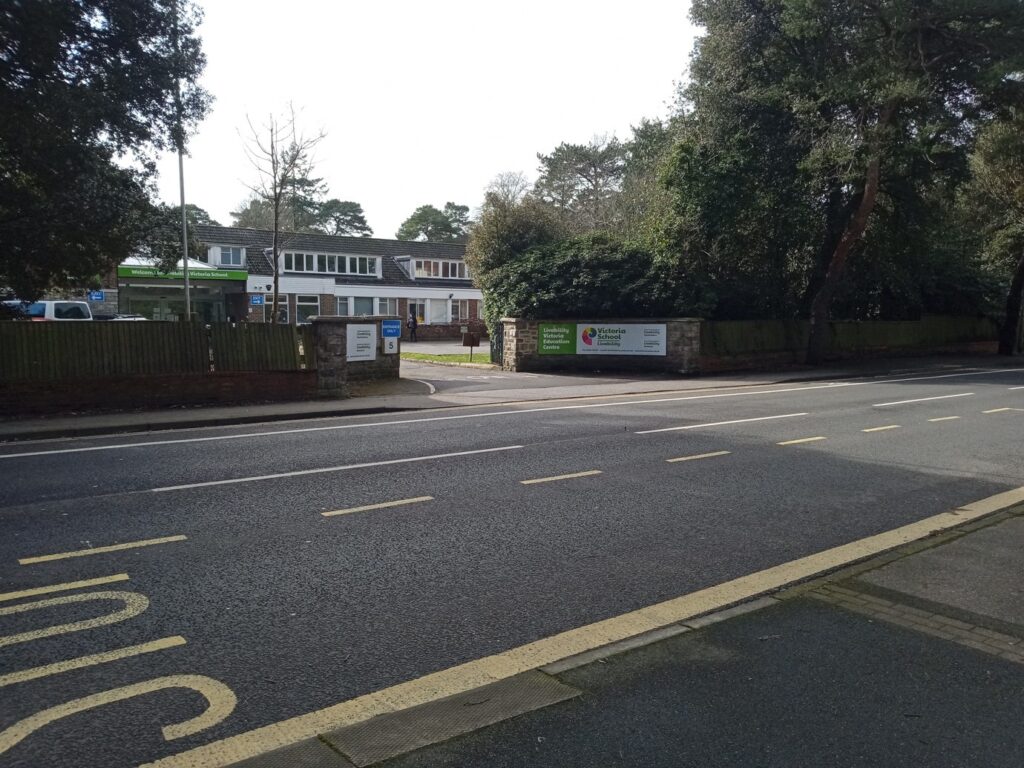
The new office was built on heathland, and was described in architecture magazines at the time as being a very modern building of unique design, comprising large aluminium framed double-glazed windows to provide maximum light.
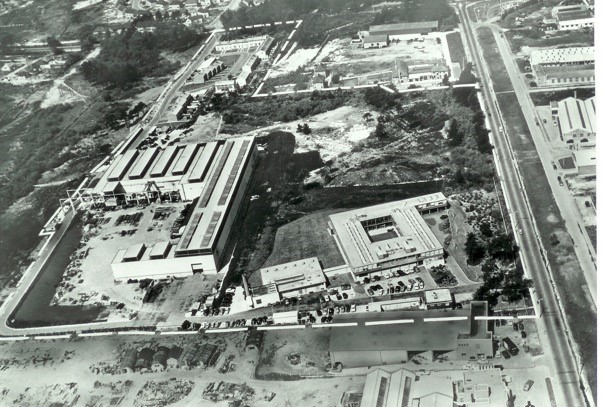
Two unusual features were incorporated into the building during its construction. One was a large ammonite discovered when the foundations were being constructed. It was retained and positioned in a prominent area within the building on completion.
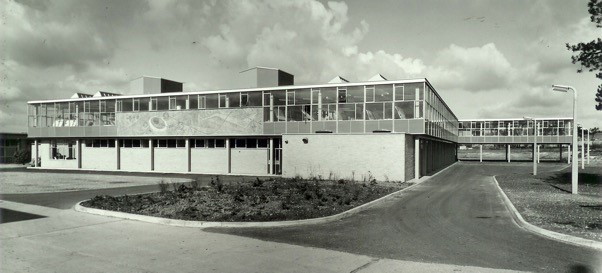
The second feature was a large and striking mural designed by Bournemouth Art College students to a theme suggested by the Architects.
It comprised a mosaic of pebbles brought from Chesil beach (strictly not allowed these days!) and many varied aluminium profiles representing typically the products produced on some of the hydraulic presses the company was involved in designing at that time.
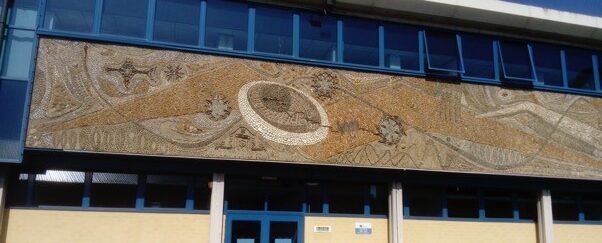
A fascinating description of the construction of the mural can be found in “Dorset Life,” November 2017. The offices and the mural can still be clearly seen from the entrance to what is now known as Discovery Court, a complex of mixed enterprises on Wallisdown Road, Poole close to the “Miller and Carter” restaurant.
Unfortunately, in the 1960’s, The Loewy Engineering Company went through a period of take-overs and mergers involving a number of name changes but in spite of a number of set-backs over the ensuing years, continued Ludwig Loewy’s leadership as a world class international engineering company in its field of designing and manufacturing rolling mills and equipment for the aluminium and steel producing industry.
After the move to Wallisdown Road, a factory was constructed on land adjacent to the new offices.
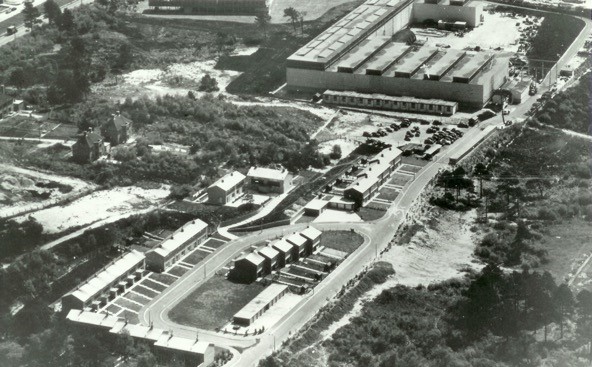
In order to encourage employees to move from Yeovil where Loewy Engineering originally had a separate manufacturing facility, the Company built houses close to the factory and offered them to employees on very favourable financial terms.
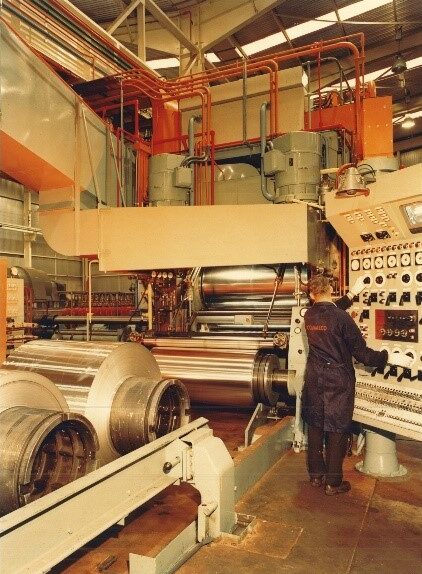
1980–1996: The Beginning of The End
In the late 1980’s and through the 1990’s the Company, now known as Davy McKee, went through a period of decline; the reasons for this are however, not for this article. Eventually, the company went the same way as so many other great British firms and finally closed its doors in 1996 with the loss of over 500 employees.
This was exactly 60 years after Ludwig Loewy felt driven from Germany, the quiet and modest man driven from the country he had so loyally served and which then had no time for him because of his ancestral background. Through his determined spirit, engineering skills and entrepreneurial expertise he provided so many local people and beyond with employment and training for a career in technology.
—
Finally, it would not be fair to leave the reader with the impression that Ludwig Loewy’s name and legacy would go unmarked.
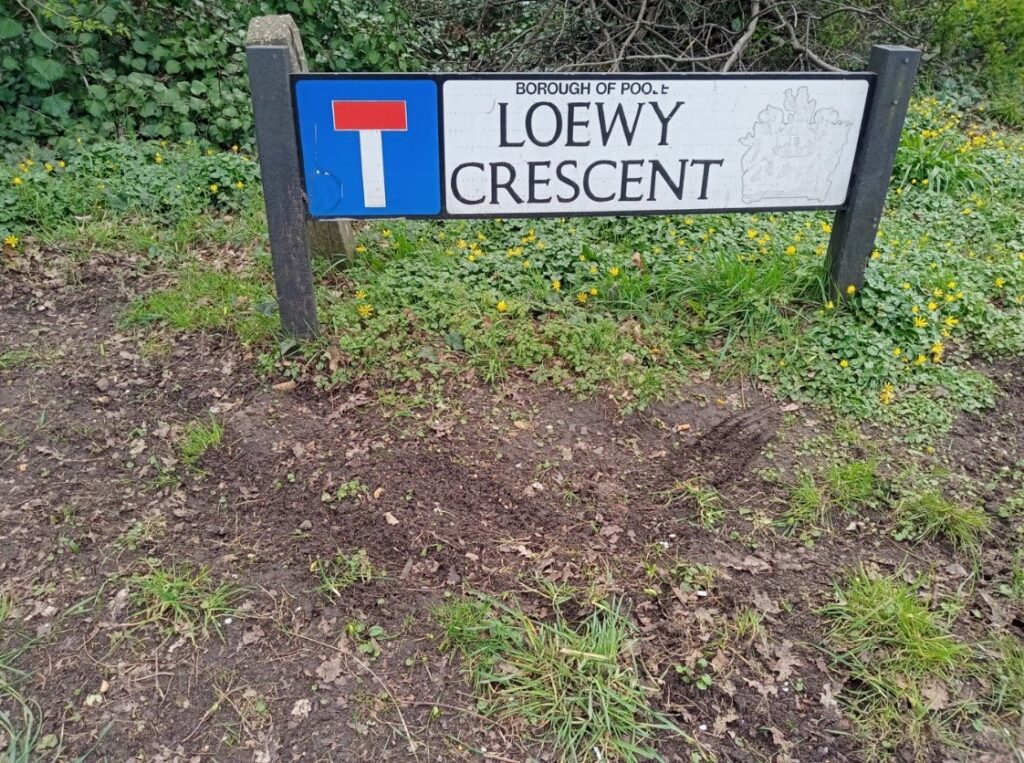
Also, In 1954 Jacob Epstein was commissioned by the Loewy family to produce a bust of Ludwig Loewy.
The sculpture was made from a photograph of Ludwig and six were cast in bronze, one of which was positioned within the Wallisdown offices.
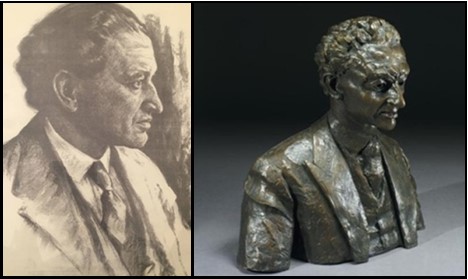
When the offices closed a mystery surrounded its whereabouts together with a portrait of Ludwig. They have both been located and are on display in an engineering office in Christchurch.
—
Author: Ian Livingstone
The author is also conducting research into the family of Ludwig Loewy to establish if all survived WW2, and the whereabouts of any living relatives. In addition, the author acknowledges the following who, without their considerable assistance, this article could not have been produced:
- The Dorset History Centre, its staff and research facility.
- The late Mike Drayton whose family donated documents and photos to Dorset History Centre.
- Dorset Life Magazine
- Past employees of Loewy Engineering Ltd/ Davy McKee Ltd


Most interesting reading about the Lowey family. Such talented family. What a pity that the revelavent photographs did not appear on your grand article.
Hi Cecilia, thank-you for your comment. Unfortunately there has been an issue with photographs and images on the site recently, which we are trying to resolve as soon as we can. We hope you will check back in coming weeks!
Thank you for your kind comment Maria. Since publication of the article I have located and exchanged emails with the daughter of Erwin Loewy (the family who were being hunted by the Nazis in occupied France) and the niece of Ludwig Loewy. A most interesting lady who is 85 years young and who lives in New York. She became an international concert pianist at the age of 13!
So much careful research has gone into uncovering this thought provoking story. Thanks Ian
The Wallisdown Road offices are described in Sir Nikolaus Pevsner’s Buildings of England as the best of their type in Europe. References to Mies van der Rohe and the forty inch module.
Thanks Phil. Most useful. I’ll look it up.
Excellent! I am trying to find photos of apprentices at Loewy Engineering 1960/1 and looking for Malcolm Boucher
Excellent piece. Other Loewy siblings were sister Clara whyo ended up in Canada with her husband Rudolf Lustig who was in the lumber business and represented Loewy Hydropress in Canada. Another brother was my Uncle by marriage, Frederick Loewy (1893-1971) who lived in New York City with his wife, my Aunt Alice.
Something else that deserves mention. Loewy Hydropress USA designed and built the then largest standing machine in the world in 1955. It was a 50,000 ton per square inch press conceived by Erwin Loewy and his most brilliant engineering associate, Hugo Lorant.
Thank you, Eric. I have just revisited my article and found your most interesting comments.
I am aware of the 50,000 ton hydraulic press “Major” which it has been said is named after Major Cudebec who, with strong connections to US
Government officials, arranged in 1940 for Erwin and his family to enter and settle in the US. “Major” is understood to be still in operation and many aircraft flying today owe their “birth” to components produced by this giant hydraulic press.
“Major” had a smaller twin, “Minor” whose pressure displacement was 35 thousand tons per square inch. Erwin Loewy’s nicknames for them were “Ludwig” for “Major” and “Hugo” for “Minor.” Hugo was in honor of Erwin’s engineering associate, Hugo Lorant.
Also, Siegmund Loewy was the oldest of the brethren, born in 1885. Alfred was the youngest, born in 1903. Siegmund died at age 57, not at forty-something. The sister Erna, was a real character, someone whom it would have been unwise to encounter in a Manhattan alleyway at midnight.
My father worked at Loewy’s from 1939 to 1969
I have some really quite interesting letters and photos that
might interest you from when the company was working in Germany
after WW2 and were contracted to dismantle german factories
to put them beyond use.
I have letters from the British military in Hannover to “Hydro-press” New York as well as my fathers transit papers to let him enter Germany.
Also photos of Nazi jet fighter planes from which they removed the engines.
Hello Robin,
I was most interested to read your comments regarding the documents you hold and also your father’s long employment with Loewy Engineering particularly as he would have been a founding employee when Ludwig Loewy relocated the Company from London to Branksome Grange in 1939. I have lists of employees who he would have known. We have three or four retirees who were working at Branksome Grange and attend our regular Retirement Association talks who, I’m sure, would have known your father.
I’ll try to contact you through the Dorset History Centre with a view to us exchanging information.
Hello Ian,
I came across this by chance. I remember you at Pool and I am so impressed that you took on the task of recording a little bit of history of Davy Loewe.
How sad it all ended.
David Storer
Hello,
I am not sure whether my memories of Loewy Engineering would be of any interest to you, but feel free to contact me.
My apprenticeship ran from 1957 to 1962, after which I was chosen along with Tom Barker, to operate as a troubleshooting unit, ready to go to at short notice to customers with Forging/Extrusion press problems.
This continued until late 1965 when I moved to Canada.
Hi David,
We have a Lowey 1250 ton extrusion press made in 1957 and it’s still in working conditions. We only substituted the main pump which was damaged by inappropriate use. That prooves the ingenious design and excellent quality.
Unfortunately the hydraulic schematic went missing. Would it perhaps be available?
I would appreciate your help immensely
Regards
Enrico
My father Hugh “Don” Ross joined Loewys in 1946. He trained as a toolmaker at Robertsons in Bedford and moved to better himself by becoming a design engineer. He spoke with pride at working ‘amongst the raspberry canes’ and of the state of the art new offices. Loewys were the best sort of paternalistic employer but the later mergers and takeovers ruined this. Dad retired in 1985.
My father, John Spence, joined Loewy Engineering Co in Kingsway, London in 1936 as a clerk, but progressed to be an apprentice draughtsman. The Chief Engineer was a Russian called Langen. In 1939, the American engineers returned home, the German staff went to an internment camp on the Isle of Man for vetting, and my father with the other staff, joined later by the Germans (or most of them), relocated to Branksome Grange in Westbourne. The head draughtsman was called Wutcher. A large local house was taken over as a hostel for the men*, secretarial staff stayed in Sandalwood Cottage on Western Avenue.
In about 1942, my father spent several months installing aluminium extrusion presses at Kitts Green, Birmingham (British Aluminium?). By the end of the war my father had finished his apprenticeship and got a job at Loewy Robertson the steel rolling mills in Bedford. He later worked at Alcan in Rogerstone (South Wales) and retired in 1985.
He always said that they treated everyone very well at Branksome and it was more like a family. *I have a photograph of residents at the hostel.
Peter, there is a “round-robin” letter addressed to “The Directors of the Loewy Engineering Co.Ltd” and dated 22nd December 1938. This letter thanks the directors for their kind seasonal wishes and gifts received. (As you say, the firm treated everyone very well.) At this time, Loewy Engineering was based at Ingersoll House, 9 Kingsway in London, close to the Aldwych.
Your father clearly signs himself on this letter “B.J.Spence”. He was one of 62 members of staff who signed this letter of appreciation, though no doubt there were others working out in the field procuring components or commissioning plant and not present in the office to sign. Theodor Wutcher also signed the letter.
The letter is part of the extensive archive at Lehigh University’s Linderman Library in Pennsylvania recording the work of Ludwig and Erwin Loewy. The precise reference is Lehigh, SC MS 0078.19.02.
Kitts Green, Birmingham was then operated by James Booth and Company. I believe the plant was opened just before WW2 as a supplement to their existing works at Nechels, Birmingham. Loewy later supplied a large plate mill to Kitts Green for rolling aluminium during the early 1960’s. This was designed in the Wallisdown Road, Poole Office.
Extremely interesting article – thanks. My grandfather was E R Henschker (Erhard) who came over with Loewy and worked at Loewy as a design engineer, eventually retiring as a director in 1965 but died shortly afterwards from heart failure. My mother, who was 5 when they came over from Czechoslovakia, told me yesterday how Erhard and Siegmund were the only two employees working late in the office when Siegmund had a heart attack and died in Erhard’s arms – very traumatic. I’ve managed to find a number of British, German and US patents for things such as rolling mills, flying shears etc. with Erhard named as the inventor. The family were interred as enemy aliens on the Isle of Man and Erhard on the Isle of Wight briefly, but Loewy facilitated their release.
I visited a Dusseldorf in July 2025 and went to an exhibition at the Stadthaus about Jewish lives in the city from 1933 to 1945. part of the exhibition was about Jewish engineers including a display about Ludwig Loews and how his U.K. company produced pressses that were used to fabricate wing spars and other components for WW2 Avro Lancaster bombers